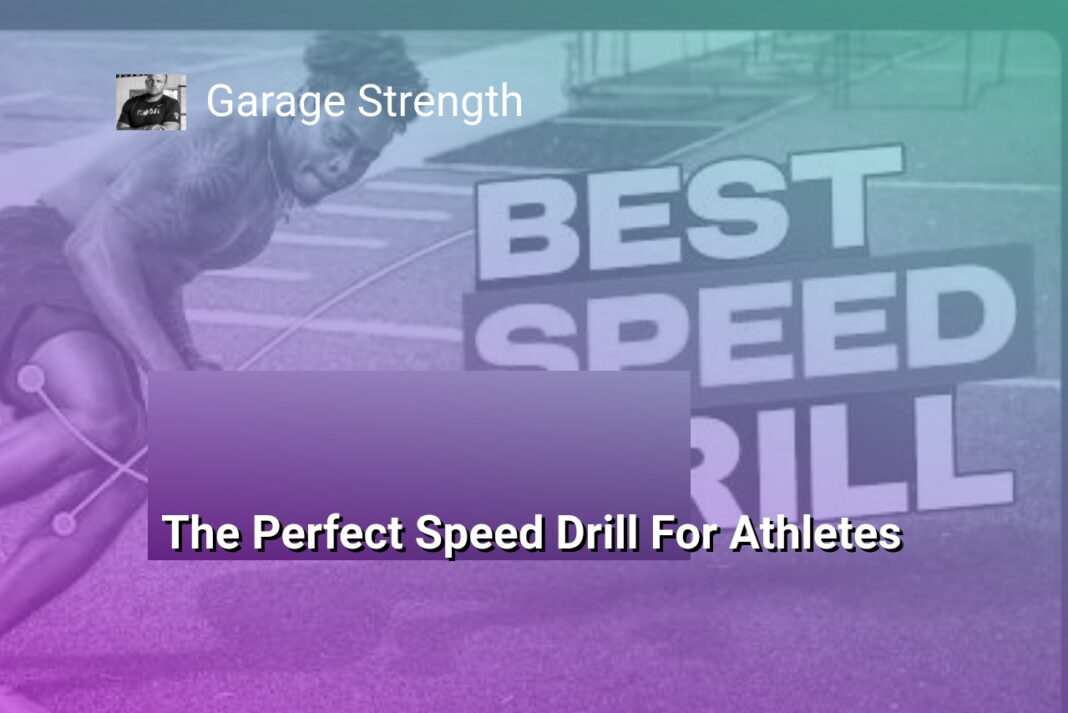The Bottom Line:
- The main theme of the text is to provide an easy agility drill that can improve overall sports performance, particularly acceleration and change of direction.
- The coach, Dane Miller, emphasizes the importance of proper hip loading and hip flexion to generate force and strike the ground effectively during acceleration.
- The wall drill is introduced as a way to help athletes feel and understand the proper hip loading and striking motion, which can be challenging for some athletes to grasp initially.
- The coach also discusses the importance of Eccentric loading and control during change of direction, highlighting the three key points: the outside plant foot, the inside (penultimate) plant foot, and the deceleration phase.
- The coach emphasizes the need to train these Eccentric forces, using tools like bungees or the 1080 device, to help athletes develop the strength and control required for faster and more efficient changes of direction.
The Importance of Hip Mechanics for Explosive Acceleration
Harnessing the Power of Hip Mechanics for Explosive Acceleration
The key to unlocking explosive acceleration lies in the efficient utilization of hip mechanics. When an athlete is able to properly load and engage their hips, they can generate a significant amount of force, which is then translated into powerful, directional acceleration.
The Importance of Hip Flexion
One of the primary aspects of hip mechanics that contributes to explosive acceleration is hip flexion. By achieving proper hip flexion, the athlete creates the necessary space between the ground and their foot, allowing them to strike the ground with greater force and efficiency. This hip flexion also enables the athlete to generate a higher knee drive, which is crucial for generating momentum and propelling the body forward.
Striking from the Hips
Another critical component of effective hip mechanics is the ability to strike the ground with force from the hips. Rather than simply pushing off the ground, the athlete should focus on actively driving their hips back and then striking the ground with a powerful, explosive motion. This hip-driven approach allows the athlete to generate more force and maintain better body positioning, leading to more efficient and explosive acceleration.
By mastering the art of hip flexion and hip-driven striking, athletes can unlock their true potential for explosive acceleration. This not only enhances their speed and agility on the field or court, but also helps to reduce the risk of injury by promoting proper body mechanics and load distribution. Through consistent practice and a deep understanding of these fundamental hip mechanics, athletes can take their performance to new heights and dominate in their respective sports.
Mastering the Wall Drill: Unlocking Hip Flexion and Powerful Ground Contact
Harnessing the Power of Hip Flexion and Ground Contact
The key to mastering the wall drill lies in unlocking proper hip flexion and maximizing ground contact. This fundamental movement pattern is the foundation for explosive acceleration and agility. By understanding and applying these principles, athletes can unlock their true potential on the field or court.
Engaging the Hips: The Driving Force
The wall drill emphasizes the crucial role of the hips in generating force and propelling the body forward. As the athlete stands in front of the wall, the focus shifts to loading the hips and striking back into the ground, rather than simply pushing off the wall. This hip-driven motion is the essence of the drill, as it teaches the athlete to harness the power of the hips to initiate movement.
Optimizing Ground Contact: The Acceleration Catalyst
The wall drill also highlights the importance of efficient ground contact. By striking the ground with the foot positioned underneath the body, the athlete can maximize the transfer of force and generate explosive acceleration. This contrasts with the common tendency to land the foot in front of the body, which can create a braking effect and hinder forward momentum.
Through the wall drill, athletes learn to maintain a high knee drive and strike the ground with the foot positioned directly under the hips. This optimized ground contact allows for a more powerful and efficient transition from the wall to the start of the acceleration phase. By mastering this fundamental movement pattern, athletes can unlock their true explosive potential and enhance their overall sports performance.
Transitioning from Acceleration to Deceleration and Change of Direction
Mastering the Transition: From Acceleration to Deceleration and Change of Direction
Transitioning from explosive acceleration to controlled deceleration and efficient change of direction is a critical skill for athletes in various sports. This seamless transition requires a deep understanding of the biomechanics involved and the ability to apply them effectively on the field or court.
The Outside Plant Foot: Initiating the Cut
The outside plant foot is the primary contact point during a change of direction. It’s the foot that first hits the ground and bears the brunt of the initial force. Proper Eccentric loading of this foot is crucial, as it allows the athlete to absorb the impact and transition smoothly into the new direction. By teaching athletes to load this outside plant foot Eccentrically, they can develop the necessary spring-like qualities to handle the high forces involved in a rapid cut.
The Penultimate Step: Offloading the Outer Foot
The penultimate, or inside, plant foot plays a vital role in effectively transitioning from acceleration to deceleration. This step helps offload the outer foot, reducing the excessive forces that can lead to injuries. By teaching athletes to utilize the inside plant foot to absorb and dissipate the forces, they can maintain control and stability during the change of direction.
The key is to ensure that the inside plant foot is Eccentrically loaded, allowing the athlete to decelerate and prepare for the final push-off in the new direction. This Eccentric loading of the penultimate step is a crucial component of safe and efficient change of direction mechanics.
Ecentric Loading: Strengthening the Body’s Spring for Faster Cuts
Harnessing the Power of Eccentric Loading for Faster Cuts
Eccentric loading is the key to unlocking explosive acceleration and agility. When an athlete is running and needs to change direction, the body acts like a spring, absorbing and storing energy during the deceleration phase. By strengthening this “spring” through targeted eccentric training, athletes can generate more force and power during the subsequent acceleration phase, leading to faster, more explosive cuts.
Mastering the Three-Point Approach to Change of Direction
The secret to effective change of direction lies in understanding and training the three critical points: the outside plant foot, the inside (penultimate) plant foot, and the deceleration phase. Each of these components relies on eccentric muscle contractions to handle the high forces involved.
The outside plant foot is the most commonly used during game situations, as it allows the athlete to quickly change direction. However, at higher speeds, the force on this foot can be too high, leading to potential injury. This is where the inside (penultimate) plant foot comes into play, absorbing the load and taking the stress off the outside foot. Finally, the deceleration phase, where the athlete “chops” their steps to slow down, is also eccentric-dominant, requiring a strong “spring” to efficiently transition into the new direction.
Developing a Powerful “Spring” through Eccentric Training
To build this explosive, injury-resistant “spring,” coaches and athletes must focus on eccentric-based exercises and drills. This can be achieved through the use of bungees, 1080 machines, or other tools that allow for controlled, high-force eccentric loading. By gradually exposing the athlete to these challenging eccentric demands, the muscles, tendons, and connective tissues become stronger and more resilient, better equipped to handle the forces of high-speed changes of direction.
Through this targeted eccentric training, athletes can unlock their true potential for explosive acceleration and agility, giving them a decisive edge on the field or court.
Putting It All Together: Integrating the Drill into Your Training
Mastering the Drill: Applying it to Your Training Regimen
Integrating the wall drill into your training regimen is a crucial step in unlocking explosive acceleration and agility. This simple yet powerful exercise can have a profound impact on your overall sports performance when implemented correctly. Here’s how you can seamlessly incorporate it into your training routine:
Progressive Overload: Gradually Increasing the Challenge
Start by mastering the basic wall drill technique, focusing on proper hip loading and striking the ground with force. Once you’ve nailed down the fundamentals, gradually increase the challenge by incorporating variations. This could include performing the drill at different angles, adding speed, or incorporating lateral movements. By progressively overloading the drill, you’ll continue to challenge your body and drive adaptations that translate to enhanced acceleration and agility on the field or court.
Targeted Integration: Aligning with Your Sport-Specific Needs
The beauty of the wall drill is its versatility. Tailor the drill to address the specific demands of your sport. For example, if you’re a basketball player, you might focus on rapid changes of direction and deceleration patterns. For a football running back, emphasizing explosive linear acceleration would be a priority. By aligning the drill with your sport-specific needs, you’ll ensure that the benefits you reap directly transfer to improved performance in your chosen discipline.
Remember, consistency is key. Incorporate the wall drill into your regular training routine, whether it’s a dedicated agility session or as a warm-up before your main workout. Gradually increase the volume and intensity as you progress, always striving to maintain proper technique. By making the wall drill a staple in your training regimen, you’ll unlock the full potential of this simple yet powerful exercise, propelling your athletic abilities to new heights.





